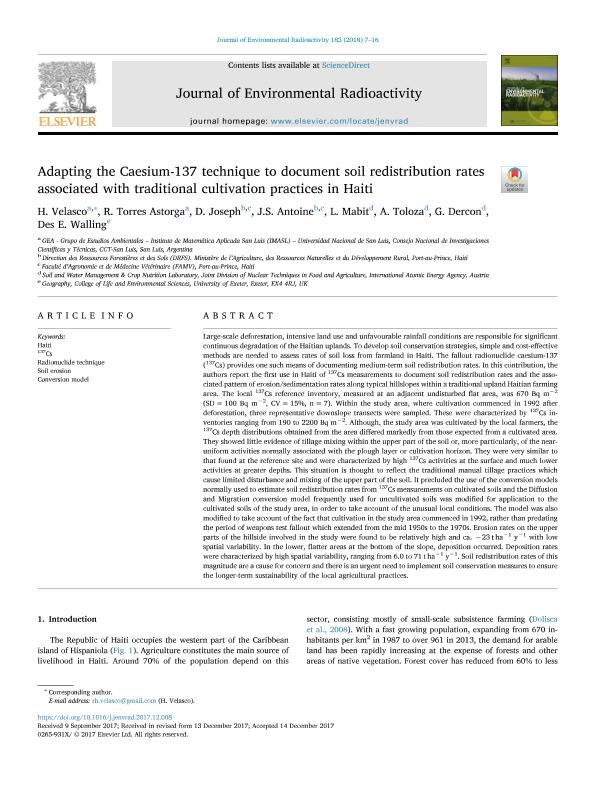Artículo
Adapting the Caesium-137 technique to document soil redistribution rates associated with traditional cultivation practices in Haiti
Velasco, Ricardo Hugo ; Torres Astorga, Romina Vanesa
; Torres Astorga, Romina Vanesa ; Joseph, D.; Antoine, J. S.; Mabit, L.; Toloza, A.; Dercon, G.; Walling, Des E.
; Joseph, D.; Antoine, J. S.; Mabit, L.; Toloza, A.; Dercon, G.; Walling, Des E.
 ; Torres Astorga, Romina Vanesa
; Torres Astorga, Romina Vanesa ; Joseph, D.; Antoine, J. S.; Mabit, L.; Toloza, A.; Dercon, G.; Walling, Des E.
; Joseph, D.; Antoine, J. S.; Mabit, L.; Toloza, A.; Dercon, G.; Walling, Des E.
Fecha de publicación:
03/2018
Editorial:
Elsevier
Revista:
Journal of Environmental Radioactivity
ISSN:
0265-931X
Idioma:
Inglés
Tipo de recurso:
Artículo publicado
Clasificación temática:
Resumen
Large-scale deforestation, intensive land use and unfavourable rainfall conditions are responsible for significant continuous degradation of the Haitian uplands. To develop soil conservation strategies, simple and cost-effective methods are needed to assess rates of soil loss from farmland in Haiti. The fallout radionuclide caesium-137 (137Cs) provides one such means of documenting medium-term soil redistribution rates. In this contribution, the authors report the first use in Haiti of 137Cs measurements to document soil redistribution rates and the associated pattern of erosion/sedimentation rates along typical hillslopes within a traditional upland Haitian farming area. The local 137Cs reference inventory, measured at an adjacent undisturbed flat area, was 670 Bq m−2 (SD = 100 Bq m−2, CV = 15%, n = 7). Within the study area, where cultivation commenced in 1992 after deforestation, three representative downslope transects were sampled. These were characterized by 137Cs inventories ranging from 190 to 2200 Bq m−2. Although, the study area was cultivated by the local farmers, the 137Cs depth distributions obtained from the area differed markedly from those expected from a cultivated area. They showed little evidence of tillage mixing within the upper part of the soil or, more particularly, of the near-uniform activities normally associated with the plough layer or cultivation horizon. They were very similar to that found at the reference site and were characterized by high 137Cs activities at the surface and much lower activities at greater depths. This situation is thought to reflect the traditional manual tillage practices which cause limited disturbance and mixing of the upper part of the soil. It precluded the use of the conversion models normally used to estimate soil redistribution rates from 137Cs measurements on cultivated soils and the Diffusion and Migration conversion model frequently used for uncultivated soils was modified for application to the cultivated soils of the study area, in order to take account of the unusual local conditions. The model was also modified to take account of the fact that cultivation in the study area commenced in 1992, rather than predating the period of weapons test fallout which extended from the mid 1950s to the 1970s. Erosion rates on the upper parts of the hillside involved in the study were found to be relatively high and ca. −23 t ha−1 y−1 with low spatial variability. In the lower, flatter areas at the bottom of the slope, deposition occurred. Deposition rates were characterized by high spatial variability, ranging from 6.0 to 71 t ha−1 y−1. Soil redistribution rates of this magnitude are a cause for concern and there is an urgent need to implement soil conservation measures to ensure the longer-term sustainability of the local agricultural practices.
Palabras clave:
137CS
,
CONVERSION MODEL
,
HAITI
,
RADIONUCLIDE TECHNIQUE
,
SOIL EROSION
Archivos asociados
Licencia
Identificadores
Colecciones
Articulos(IMASL)
Articulos de INST. DE MATEMATICA APLICADA DE SAN LUIS
Articulos de INST. DE MATEMATICA APLICADA DE SAN LUIS
Citación
Velasco, Ricardo Hugo; Torres Astorga, Romina Vanesa; Joseph, D.; Antoine, J. S.; Mabit, L.; et al.; Adapting the Caesium-137 technique to document soil redistribution rates associated with traditional cultivation practices in Haiti; Elsevier; Journal of Environmental Radioactivity; 183; 3-2018; 7-16
Compartir
Altmétricas



